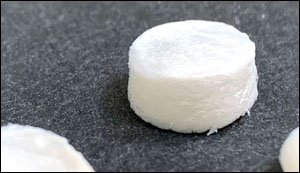Ultra-lightweight ceramic material that can better withstand extreme temperatures
15. 2. 2019 | UCLA | www.ucla.edu
UCLA researchers and collaborators at eight other research institutions have created an extremely light, very durable ceramic aerogel. The material could be used for applications like insulating spacecraft because it can withstand the intense heat and severe temperature changes that space missions endure.
Ceramic aerogels have been used to insulate industrial equipment since the 1990s, and they have been used to insulate scientific equipment on NASA’s Mars rover missions. But the new version is much more durable after exposure to extreme heat and repeated temperature spikes, and much lighter. Its unique atomic composition and microscopic structure also make it unusually elastic.

When it’s heated, the material contracts rather than expanding like other ceramics do. It also contracts perpendicularly to the direction that it’s compressed — imagine pressing a tennis ball on a table and having the center of the ball move inward rather than expanding out — the opposite of how most materials react when compressed. As a result, the material is far more flexible and less brittle than current state-of-the-art ceramic aerogels: It can be compressed to 5 percent of its original volume and fully recover, while other existing aerogels can be compressed to only about 20 percent and then fully recover.
Read more at UCLA
Image Credit: Oszie Tarula/UCLA
-jk-




